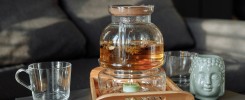“Caffeine is only part of the story. What really matters is how it interacts with the leaf, the fermentation, and your body.”
— From my years sourcing and cupping teas across Yunnan and Assam
When I get asked whether Pu-erh tea has a lot of caffeine, my instinct is always to answer upfront:
It depends — but in my experience, Pu-erh tea is generally moderate in caffeine compared to black tea.
I’ve found that fresh Sheng (raw) Pu-erh from young buds can sometimes match or slightly exceed black tea in caffeine, while aged Sheng or Shou (ripe) Pu-erh usually has less. But over the years, I’ve learned that numbers alone don’t tell the full story. The way Pu-erh affects your alertness and focus is often more subtle, more balanced, and longer-lasting than black tea.
Table of Contents
1. Caffeine Isn’t Just About Numbers
I’ve spent decades cupping teas from the misty mountains of Yunnan to the sprawling estates of Assam. What I’ve learned is that caffeine is never just a static number.
- Leaf origin and type matter more than most people realize. Black teas are usually cultivated bushes selected for yield and consistency. Pu-erh, in contrast, comes from large-leaf Camellia sinensis var. assamica, often from older trees. I’ve cupped young Sheng leaves from these trees that were surprisingly high in caffeine — sometimes rivaling strong Assam black tea.
- Processing makes a difference. Black tea is fully oxidized, producing a quick, noticeable lift. Sheng Pu-erh ferments naturally over years, while Shou Pu-erh undergoes accelerated microbial fermentation. Fermentation doesn’t remove caffeine dramatically, but it changes how it interacts with other compounds, like theanine and GABA. From my experience, this is why Pu-erh often feels smoother and more balanced.
- Aging changes perception. Many people think older Pu-erh is “stronger.” I’ve cupped decades-old Sheng and Shou teas, and while they feel full-bodied and potent, the actual caffeine content is often lower than fresh black tea. What you sense is the combination of flavor, body, and subtle chemical interactions.
2. Caffeine in Practice
Based on my tasting and sourcing experience:
- Black tea (Assam, Darjeeling, Ceylon): ~40–70 mg per 240ml cup — delivers an immediate energy spike.
- Sheng Pu-erh (fresh): ~30–60 mg per cup — young buds often reach the higher end.
- Shou Pu-erh (ripe): ~20–45 mg per cup — fermentation reduces extractable caffeine, giving smoother stimulation.
I remember brewing a fresh Sheng Pu-erh alongside a strong Assam once. The caffeine content was nearly identical, but the sensation was different. The Assam jolted me sharply, while the Pu-erh gave a balanced, sustained alertness. That’s the difference I notice repeatedly over years of cupping and advising clients.
3. The Synergy of Compounds
Over two decades, I’ve learned that caffeine never works alone. Pu-erh contains:
- L-theanine, which tempers caffeine and creates calm focus.
- GABA and fermentation metabolites, which slow caffeine absorption and extend alertness.
- Polyphenols, which contribute to body, flavor, and perceived strength.
This is why I often tell tea lovers that Pu-erh is energizing yet grounding. Black tea gives you a quick lift; Pu-erh gives you a steady, layered energy that feels richer and more nuanced.
4. Brewing Shapes the Experience
I always emphasize to my clients that how you brew Pu-erh influences caffeine perception as much as the leaf itself:
- Gongfu-style short infusions gradually release caffeine and flavor.
- Multiple infusions allow repeated enjoyment without overstimulation.
- Water temperature matters: 90–95°C for Pu-erh, 95–100°C for black tea.
I’ve seen beginners overbrew Pu-erh, expecting a caffeine spike like black tea, only to end up with bitterness and a harsh cup. Proper technique reveals its nuanced stimulant profile and full flavor potential.
5. My Professional Takeaway
So, does Pu-erh tea have a lot of caffeine? From my perspective:
- Fresh Sheng can rival strong black tea, but usually not exceed it significantly.
- Shou and aged Sheng generally contain less caffeine but produce a smoother, longer-lasting alertness.
- The experience matters more than the number. Pu-erh balances energy and calm in a way black tea rarely achieves.
For me, caffeine is just the beginning. Drinking Pu-erh is a lesson in balance, patience, and mindful enjoyment. Over twenty years, I’ve realized that understanding how Pu-erh interacts with your body transforms every cup into a nuanced, satisfying journey — far beyond a simple caffeine hit.

